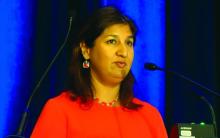Ubrogepant
Dr. Lipton also presented the results of ACHIEVE II, a multicenter, double-blind, phase 3, placebo-controlled study of the oral CGRP receptor antagonist ubrogepant at 25 or 50 mg versus placebo in 1,355 patients with episodic migraine. Like rimegepant, it met both FDA-required primary endpoints. The pain freedom rate 2 hours post dose was 20.7% with ubrogepant at 25 mg, 21.8% with 50 mg, and 14.3% with placebo. The most bothersome symptom was gone at 2 hours in 34.1% of patients who received the CGRP receptor antagonist at 25 mg, 38.9% of those who got the 50-mg dose, and 27.4% of controls.
David W. Dodick, MD, explained the rationale for CGRP inhibition: CGRP and its receptors are highly expressed in pain-sensitive trigeminal sensory neurons, which innervate the dura and meningeal blood vessels. During the headache phase of migraine, the peptide is released in excess, making CGRP a key player in the pathophysiology of migraine.
Dr. Dodick presented an update focused on secondary endpoints in the phase 3, double-blind ACHIEVE I trial, whose positive co-primary outcomes have previously been reported. The analysis included 1,327 episodic migraine patients who were randomized to ubrogepant at 50 or 100 mg or placebo. Among the notable secondary outcomes was the clinically important rate of pain relief at 2 hours: 61% in both ubrogepant groups, significantly better than the 49% rate with placebo. Also, in terms of pain freedom, the 2-hour rate underestimated the true efficacy patients would experience in clinical practice: the maximum pain freedom rate occurred at 3 hours and was sustained to 8 hours post dose.
At the time study participants took their pill, only 30% indicated they were capable of functioning normally. Two hours later, this was still the case in 29.8% of placebo-treated controls, as compared with 40.6% on ubrogepant at 50 mg and 42.9% who took 100 mg of the drug. The proportion of patients who said they were satisfied or extremely satisfied with their treatment at the 2-hour mark was 24.1% in the placebo arm and 36.3% and 35.8% in the lower- and higher-dose ubrogepant arms, reported Dr. Dodick, professor of neurology at the Mayo Clinic in Scottsdale, Ariz.
Lasmiditan
Sheena K. Aurora, MD, presented the results of SAMURAI and SPARTAN, two randomized, double-blind, phase 3 clinical trials comparing lasmiditan versus placebo for the treatment of acute migraine in a collective 3,701 patients with longstanding episodic migraine, one-third of whom had a history of aura.
Lasmiditan is a novel oral serotonin receptor agonist that penetrates the CNS and selectively targets the 5-HT 1F receptor. The drug doesn’t cause the vasoconstrictive effects that make triptans, which target 5-HT 1B/1D receptors, contraindicated in patients with cardiovascular disease.
Indeed, SPARTAN included patients with known cardiovascular disease. SAMURAI did not; however, migraine is now recognized as an independent cardiovascular risk factor, and 80% of SAMURAI participants had one additional standard cardiovascular risk factor, such as diabetes, smoking, or hypertension.
SAMURAI randomized patients to lasmiditan at 100 or 200 mg or placebo to be taken within 4 hours of migraine onset, when the pain was of at least moderate severity. SPARTAN randomized patients to lasmiditan at 50, 100, or 200 mg or placebo.
A dose-response effect was noted. At 2 hours post dose of lasmiditan at 200 mg, 32.2% of patients in SAMURAI and 38.8% in SPARTAN were pain-free, compared with 15.3% and 21.3% on placebo, respectively. At the top dose of lasmiditan, 40.7% of patients in SAMURAI were free of their most bothersome baseline symptom, as were 48.7% in SPARTAN, with placebo response rates of 29.5% and 33.5%, respectively, for this endpoint. A significant separation from placebo was noted in 1 hour for the pain freedom endpoint, and in about 30 minutes for freedom from the most bothersome symptom, reported Dr. Aurora of Eli Lilly, which sponsored the trials.
Lasmiditan at 50 and 100 mg also significantly outperformed placebo for the co-primary endpoints.
As in the phase 3 trials of the two investigational oral CGRP antagonists, a secondary endpoint in SPARTAN and SAMURAI was pain relief at 2 hours, a lower bar than pain freedom. The rates in the lasmiditan 200 mg arms were 60%-65%, compared with about 40% with placebo.
Treatment-emergent adverse event rates were 11%-15% with placebo and in the 40% range for lasmiditan. Because the drug penetrates the CNS, centrally acting side effects were an issue. Dizziness was the most common, followed by paresthesia, somnolence, then fatigue. The dizziness was dose dependent: In SPARTAN, the complaint was noted in 2.5% of placebo-treated controls, 25.4% of patients on 50 mg of lasmiditan, 36.1% with 100 mg, and 39% at 200 mg.
Chest tightness, a common side effect with triptans, did not occur.
A large multicenter, open-label safety assessment study, called GLADIATOR, is ongoing.


